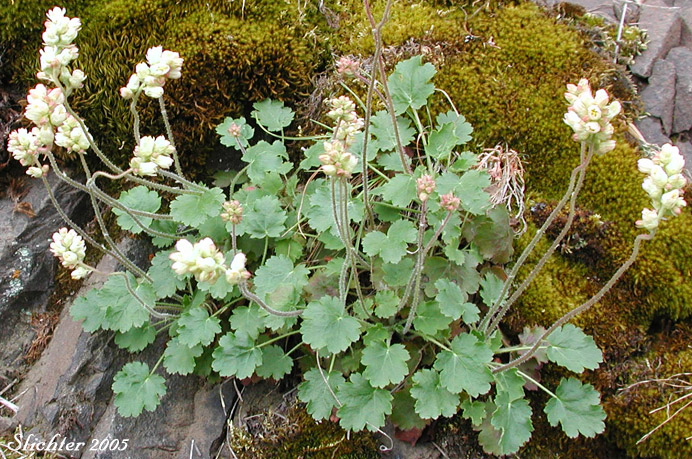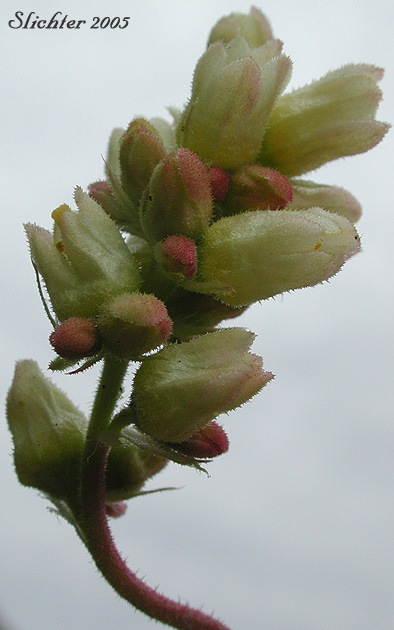
 The
photo at right shows a close-up of the congested spike of flowers of roundleaf
alumroot (var. cylindrica). Photographed along the south side of Interstate
84 about one-half mile west of Celilo, OR............April 24, 2005.
The tubular flowers end in whitish lobes that are really sepals or calyx lobes,
not petals. When present, the petals will be found between the large, round-tipped
calyx lobes. The petals are linear and up to half the length of the calyx
lobes.
The
photo at right shows a close-up of the congested spike of flowers of roundleaf
alumroot (var. cylindrica). Photographed along the south side of Interstate
84 about one-half mile west of Celilo, OR............April 24, 2005.
The tubular flowers end in whitish lobes that are really sepals or calyx lobes,
not petals. When present, the petals will be found between the large, round-tipped
calyx lobes. The petals are linear and up to half the length of the calyx
lobes.
Roundleaf or mat alumroot is an attractive perennial with erect or ascending stems from 10-45 cm in height arising from a cluster of basal leaves atop a thick, horizontal rhizome or rootstock with old leaf-bases. The herbage may be smooth to glandular hairy below and usually thickly glandular hairy above. The stems lack leaves or may have several small bracts up to 1 cm long. The leaf blades are broadly ovate to oval, or they may be kidney- to heart-shaped. The blades are 1.6-3.5 cm long and 1.4-3.2 cm wide. The base of the blade is heart-shaped. The margins are 5-7 lobed with coarse teeth on each lobe. The petioles are 1-8 cm long and may be smooth or hairy.
The inflorescence is a congested panicle or elongated cluster of flowers. The inflorescence varies from smooth surfaced to hairy and very glandular. The pedicels are up to 3.5 mm long. The yellow-green to cream calyx is narrowly bell-shaped and 3.5-5 mm long with pale yellow to cream, obtuse to rounded lobes. The lobes are shorter than the length of the tube. The petals are typically either lacking or are much shorter than the calyx-lobes. If present, they are linear in shape. The stamens are shorter than the calyx lobes.
var. alpina: Leaf blades thick and under 2.5 cm wide (slightly longer). The base of the blade varies from rounded to heart-shaped (See photo at lower right.). Lower stems and blades finely glandular hairy.
var. glabella: Leaf blades thinner and over 2.5 cm wide. The base of the blade is definitely heart-shaped. Lower stems , leaves, and petioles often smooth surfaced or sparsely glandular hairy.
var. cylindrica: Leaf blades thinner and over 2.5 cm wide. The base of the blade is definitely heart-shaped. Lower stems and petioles and petioles glandular hairy to coarsely and stiffly haired.
Roundleaf alumroot may be found on rocky and talus slopes and on cliffs, often in crevices or cracks in rock outcrops.
Roundleaf alumroot may be found from British Columbia south on the eastern side of the Cascades to central Oregon and northeastern California. To the east it may be found to Alberta, and south in the Rockies to Montana, northwestern Wyoming and northern Nevada.
In the Columbia River Gorge, roundleaf alumroot may be found at about 200' on basalt cliffs on the south side of Interstate 84 immediately west of Celilo, OR.